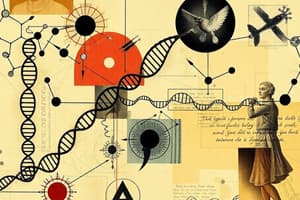Podcast
Questions and Answers
What role do ribonuclease and deoxyribonuclease play in the digestion of nucleotides?
What role do ribonuclease and deoxyribonuclease play in the digestion of nucleotides?
- They denature proteins in the stomach.
- They absorb nucleotides directly into the bloodstream.
- They break down RNA and DNA into shorter fragments. (correct)
- They convert nucleosides into uric acid.
Which statement accurately describes the function of nucleotidases in nucleotide digestion?
Which statement accurately describes the function of nucleotidases in nucleotide digestion?
- They facilitate the reabsorption of purines and pyrimidines.
- They break down nucleosides into individual phosphate groups.
- They are produced by the pancreas to digest DNA.
- They convert nucleotides into nucleosides by removing phosphate groups. (correct)
Where does the majority of nucleotide digestion occur, and what enzymes are primarily responsible for it?
Where does the majority of nucleotide digestion occur, and what enzymes are primarily responsible for it?
- In the liver with the help of nucleosidases.
- In the small intestine via ribonuclease and deoxyribonuclease. (correct)
- In the stomach through pepsin enzymes.
- In the large intestine using brush border enzymes.
What occurs to purines after they have been metabolized inside red blood cells?
What occurs to purines after they have been metabolized inside red blood cells?
How does the body regulate the enzymes involved in nucleotide digestion?
How does the body regulate the enzymes involved in nucleotide digestion?
Flashcards are hidden until you start studying
Study Notes
Nucleotide Digestion
- The process of digesting nucleotides begins in the stomach, where the acidic environment breaks down proteins and cell membranes.
- The majority of nucleotide digestion occurs in the small intestine.
- The pancreas secretes ribonuclease and deoxyribonuclease, which break down RNA and DNA into smaller fragments.
- Brush border enzymes in the small intestine further break down these fragments into individual nucleotides (mononucleotides).
- Nucleosidases remove phosphate groups from nucleotides, releasing nucleosides, which are taken into red blood cells (RBCs).
- Nucleosidase enzymes within RBCs break down nucleosides into purines/pyrimidines and sugars.
- Pyrimidines and ribose/deoxyribose phosphates are reabsorbed and used by the body, while purines are mostly degraded to uric acid and excreted.
- Feedback mechanisms regulate the production and release of pancreatic enzymes involved in nucleotide digestion.
- High levels of mononucleotides can downregulate the release of nucleotide-digesting enzymes to prevent excessive digestion.
Studying That Suits You
Use AI to generate personalized quizzes and flashcards to suit your learning preferences.




